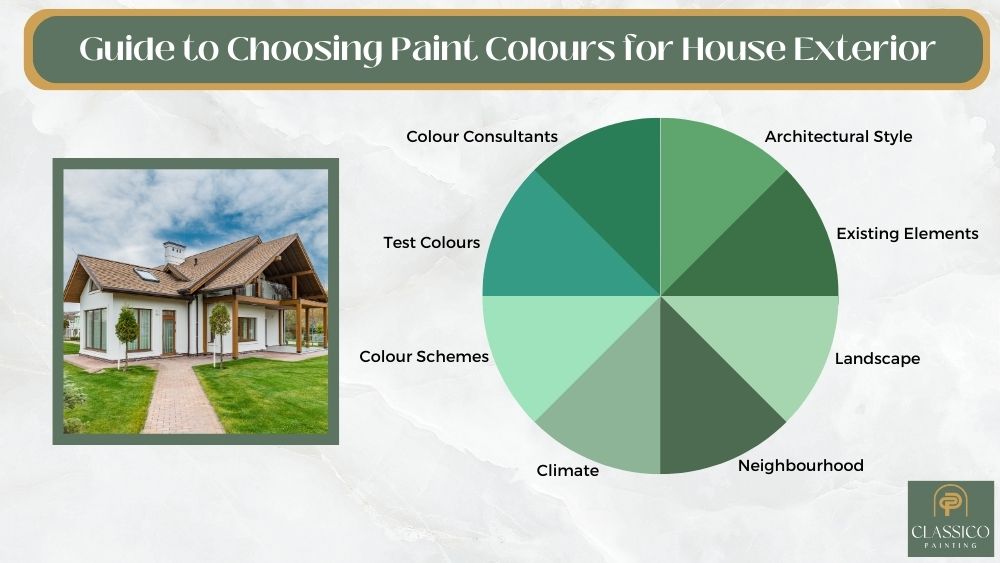Are you ready to paint your home’s exterior? We know that choosing the right paint colour can be daunting. But don’t worry!
We’ll guide you through each step, provide some inspiration and even help test your choices.
You’ll also learn about the popular exterior house colours and choosing the paint colours for house interior if you want to transform the inside of your house too.
Let’s start with these 8 tips on how to choose the paint colours for your house exterior.

1. Consider the House Architectural Style
You’ve got to consider your house’s architectural style when choosing exterior paint colours. It’s not just about what you like; it’s about ensuring harmony between the structure and its shade.
For instance, Victorian homes often stand out with contrasting hues, while modern styles prefer monochromatic palettes.
You can’t ignore the history of your home’s design either. Craftsman bungalows look best in earth tones, while Colonial styles lean towards traditional colours. A wrong choice could make your house exterior seem out of sync with its architectural roots.
Remember, each style has a colour scheme that enhances its charm and highlights its unique features.
2. Check the Colour of the Existing Elements
Considering the existing elements like the roof, driveway, or any stonework is essential before deciding on a new scheme. When choosing exterior paint colours, they must harmonise with these parts of your home. You don’t want to pick a colour that clashes with your brickwork or roofing!
To avoid this, check the colour of these existing elements. Are they warm-toned or cool-toned? Do they have undertones of particular colours? Once you’ve figured this out, you can choose paint colours that complement them.
Imagine how awkward it would be if your grey slate roof clashed with a yellow house! So take note: Checking and considering the colours of existing elements is vital when choosing exterior paint for your house.
3. Consider the Landscape
Don’t forget to consider the surrounding natural landscape when planning your home’s new look. The colours of the trees, flowers, and other features can impact how your chosen exterior paint looks. For instance, if you’re surrounded by lush greenery, you might want to avoid greens that will make your house blend in too much.
When selecting exterior colours, consider how they’ll interact with your environment throughout the year. Will a red stand out beautifully against winter snow or clash with autumn leaves? Think about these things while choosing exterior paint.
4. Get an Inspiration from the Neighbourhood
We’ll explore how your neighbours’ homes can inspire your design choices. When contemplating paint colours for your house exterior, don’t overlook the power of drawing inspiration from your neighbourhood.
It doesn’t mean you have to copy what’s already been done, but observing and understanding the style around you can provide a valuable starting point.
For instance, if you’re in an area with historic homes, you might want to respect that aesthetic by choosing classic hues. Alternatively, bold or neutral palettes may be more fitting if your neighbourhood is filled with contemporary designs. Strolling through your local streets could reveal a colour combination you hadn’t considered before.
Remember, while taking cues from surrounding houses for cohesion in the community look is essential, it’s also crucial to let personal taste guide your decisions. After all, it’s about striking a balance between fitting in and standing out.
However, before settling on any colour palette inspired by other home exteriors in the neighbourhood or based on personal preferences alone, another critical factor is how different climates impact paint colours.
It will ensure that whatever hue you choose looks good and stands up well against mother nature’s elements.
5. Consider the Climate
When planning your home’s new look, you’ll want to consider your local climate. Your environment can significantly influence the choice of exterior paint colours.
Light shades can help reflect heat off the house and keep it more relaxed in a hot, sunny area. Darker paint colours, on the other hand, are excellent for colder climates as they absorb heat.
Consideration of weather patterns is also crucial. If you often have heavy rainfalls or intense sun exposure, opt for high-quality exterior paints with UV protection and waterproof features. This helps maintain the longevity of your chosen paint colour against fading or peeling.
6. Check Various Colour Schemes
Exploring different colour schemes before settling on one for your property’s facade is essential. You may desire a bold statement or be drawn more towards subtle harmony. Whatever your preference, the exterior colour scheme should complement the home’s architectural style and surrounding environment.
Start by looking at other homes in your neighbourhood. What paint colours do they use? Which ones stand out to you, and why? There are countless resources online as well – galleries of houses showcasing various colour schemes can offer inspiration. Remember, it’s not just about choosing a single hue but coordinating several for a cohesive look.
Once you’ve narrowed some options, don’t make any hasty decisions. It’s time now to test your colours.
7. Test Your Colours
Don’t rush into any decisions; test out your potential plans before settling on the final one.
When choosing paint colours for your house exterior, it’s crucial to see how they look in different lighting conditions and against other home elements. You might be surprised at how greatly a colour can change under sunlight or artificial light.
Get sample pots or swatches of your shortlisted colours. Apply them onto small sections of your exterior wall and observe.
This way, you’ll get a clearer idea about how the colours interact with each other and the surrounding environment. It takes time to choose paint colours that genuinely enhance your home’s appeal, but it’s worth every second spent testing and retesting until you find the perfect match.
8. Consult with a Colour Consultant
After you’ve tested out a few paint options on your house exterior, it’s wise to seek advice from a professional. That’s where a colour consultant comes in. They’re experts who specialise in creating colour schemes that enhance the look of your home.
You might think you’ve got it all figured out, but there are numerous aspects to consider when choosing paint colours for your house exterior: lighting, landscape, neighbourhood aesthetics and more.
A skilled colour consultant doesn’t just help pick the right shade; they ensure the palette complements your home’s architectural style while suiting your taste. So don’t hesitate to consult one if you’re unsure or overwhelmed by the array of choices.
It’s an investment that can save time and prevent costly mistakes.
What Are the Popular Exterior House Colours?
When you’re exploring fashionable options, neutral tones like greys and whites are often favourites for the outside of a home. They’re part of the popular exterior house colours because they provide a sleek, modern appearance that easily matches any landscaping or architectural style.
But don’t limit yourself to just these shades! Earthy colours like browns, greens, and blues can add warmth and character to the exterior of your home, too. Remember, when choosing paint colours for your house exterior, consider aesthetics and practical factors such as weather conditions and maintenance requirements.
Now that you’ve got some ideas about picking colours for the outside of your abode let’s move on to how to choose paint colours for the inside.
How to Choose Paint Colours for House Interior?
When you ask yourself on how to choose paint colours for house interior, you must consider several factors. Remember, the paint colours for the house exterior should be in harmony with your interior colours. Your exterior walls can act as a canvas that reflects your taste and style.
Consider the architectural style of your house. Is it traditional or modern? Different types often lend themselves to specific colour palettes. Also, think about kerb appeal. Does a bold colour make a statement, or would subtler tones blend better with the neighbourhood?
Get creative, but stay practical. Look at how natural light affects different shades at various times of day before making a decision. Ultimately, choose what feels suitable for you and adds value to your home.





